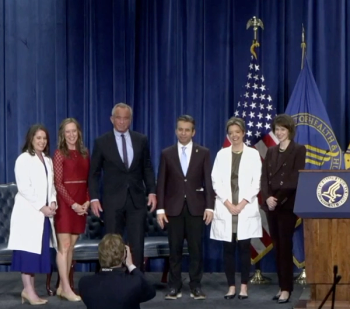
Digital twin technology: Improving workflows and patient safety in primary care
Key Takeaways
- Digital twin technology creates virtual replicas of medical devices, enhancing training, support, and maintenance in healthcare settings.
- Extended reality platforms enable immersive, scalable training, reducing the need for physical equipment access and improving staff competence.
Digital twin technology for medical device management enhances training, predictive maintenance, and remote support for improved patient care and safety.
Office-based
These demands reveal a persistent problem: training gaps, unplanned downtime and rising maintenance costs. These issues can disrupt workflows and compromise safety. To address these challenges, health care is beginning to adopt digital twin technology. Already well established in aerospace, manufacturing and logistics, digital twins create virtual replicas of medical devices that can be explored, tested and supported in digital environments. When paired with extended reality (XR) platforms, this technology offers a safer and more efficient way for physicians and staff to interact with medical devices.
What is a digital twin?
A digital twin is a virtual model of a physical device that mirrors its behavior, performance and condition. Represented in augmented reality (AR), virtual reality (VR) or mixed reality (MR), it uses a complete parts catalog to learn the machine and continuously updates based on incoming data, allowing users to simulate and analyze equipment remotely. In health care, a digital twin can represent anything from a blood analyzer to a ventilator. By integrating sensor data, usage history and manufacturer specifications, the digital twin has the ability to continuously update to reflect the actual state of the device.
Using digital twin technology accessible across extended reality platforms, manufacturers can convert existing static CAD files into interactive 3D simulations on practically any device, such as desktops, tablets, mobile devices and XR devices. Staff can interact with a life-sized virtual replica, open it up to view internal components or simulate maintenance procedures in real time. The result is a training and support tool that behaves like the real machine without interrupting patient care or risking equipment damage.
Challenges in medical device management
Managing medical devices in primary care settings presents a unique set of challenges that can strain both workflows and patient safety. Training requirements are significant, as new equipment often arrives with deep learning curves, while staff turnover demands repeated onboarding. Additionally, the pace of technological advancements has created a knowledge gap between generations of practitioners, with more experienced staff sometimes struggling to adapt to newer technologies, while younger practitioners lack experience with older equipment still in use. Traditional methods, such as printed manuals or short in-person demonstrations, rarely provide the depth needed to ensure confidence and competence.
At the same time, unplanned downtime caused by device malfunctions or improper use disrupts care delivery and can erode patient trust. Preventive maintenance routines are often reactive or based on rigid schedules, resulting in unnecessary servicing or missed opportunities to detect early-warning signs of damage. Combined with the risk of user error from incomplete training, these issues create inefficiencies that directly impact the quality of care and the overall patient experience.
Transforming workflows with digital twins
Digital twin technology has the potential to completely change how health care teams interact with medical devices by offering an integrated training, support and maintenance platform. These simulations provide a safe space to explore device functionality, practice routine tasks and prepare for rare but critical error scenarios without risking patient safety. By delivering training through XR platforms, practices can create a consistent and repeatable learning experience that adapts to individual skill levels. A 2022 PwC study found that people trained with VR were up to
Beyond training, in a sector where hands-on experience is critical but access to live equipment is limited, digital twins offer a scalable solution that improves accessibility. Users can run diagnostics, replace parts and resolve simulated errors as they would in a real-world scenario. In the primary care setting, where even short disruptions can derail schedules and inconvenience patients, these benefits translate into smoother operations and greater reliability of diagnostic and therapeutic tools.
Digital twins also enable remote collaboration. XR-enabled environments allow off-site experts to connect with clinicians or technicians directly through the device. Remote specialists can annotate a clinician’s field of view, highlight parts and guide step-by-step troubleshooting without traveling to the site. For healthcare practices in rural or resource-limited areas, this type of support ensures that expertise is not confined to large hospitals or urban centers. It also reduces the cost and time associated with in-person visits, making care delivery more efficient.
Finally, by enabling predictive maintenance, digital twins also reduce the likelihood that a critical device will fail during a patient procedure. Fewer breakdowns and delays translate directly into safer, more reliable patient treatment.
Scalability across devices and teams
A 2024 Gartner report predicted that
Through immersive XR guidance, companies have significantly reduced the need for formal operator training and the time spent creating and deploying scalable content across global teams. Likewise, visual remote assistance through digital twin technology allows technicians to receive real-time, guided support remotely from experts, eliminating costly on-site visits and speeding up maintenance resolution.
The flexibility of digital twin technology allows primary care networks or group practices to maintain standardized training and support across geographically dispersed teams. It also helps ensure that updates such as new device software or safety protocols are quickly disseminated and adopted.
Looking ahead
As medical devices grow in complexity, so does the responsibility of physicians and staff to manage them effectively. Digital twin technology offers a practical path forward: immersive training that reduces errors, predictive maintenance that minimizes downtime and remote support that extends expertise to every clinic.
Health care is entering a phase defined by simulation, data-driven insights and smart automation. While still emerging, digital twin
Gilad Tzori is the chief operating officer at frontline.io.
Newsletter
Stay informed and empowered with Medical Economics enewsletter, delivering expert insights, financial strategies, practice management tips and technology trends — tailored for today’s physicians.


















